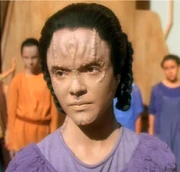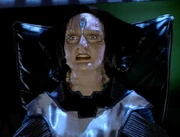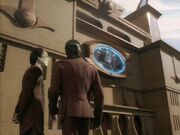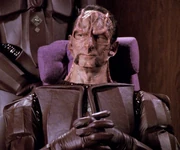Template:Fac
The Cardassians are a humanoid species from the Alpha Quadrant. They are native to the planet Cardassia Prime, capital world of the Cardassian Union.
Physiology
Gul Ocett, a female Cardassian
The Cardassians evolved from reptilian ancestors and they prefer a darker, hotter, and more humid environment than Humans. (DS9: "For the Cause")
Externally, Cardassians are easily recognizable by each having light-gray skin, two thick vertical neck ridges that recede back to the crown of their head and an inverted tear-shaped ridge in the center of the forehead. The ridge is thickest immediately above the eyes, protecting them and creating an especially deep-set appearance. There is also another inverted tear-shaped ridge feature in the center of the Cardassian chest. On Cardassian females, the ridge in the center of the forehead has a blue coloration, as does the second or third rung down on their neck ridges.
They have straight hair that varies in color from jet black to less frequently dark brown. Males typically slick their hair back, while the women have more varying hairstyles. As with Humans, their hair turns white with age. Furthermore, a Cardassian's hearing is not as acute as a Human's. (TNG: "The Wounded", DS9: "Cardassians", "Distant Voices", et al.)
- Since scale patterns on Cardassian necks have been shown to change from appearance to appearance (Garak, for example), makeup artist Michael Westmore theorized in a 2005 issue of Star Trek Insider that Cardassians continually shed and regrow scales. See below for more information on the evolution of the Cardassian "look".
Medical conditions to which Cardassians are susceptible include Coleibric hemorrhage and Yarim Fel Syndrome.
Society and culture

Cardassian orphans left on Bajor after the Occupation
Unlike Humans, Cardassians don't avoid or try to slow the aging process, instead welcoming old age and the power and wisdom it denotes. The education system implemented on Cardassia dictates that intellectual pursuits begin at the young age of 3 or 4. Every Cardassian is raised with an appreciation of fine arts and culture, though the government may not have always been so open-minded in its policies. Educational attainment is regarded as a major source of social status and the source of creativity in Cardassian society. The Cardassians are known for their photographic memories, while some even have the ability to resist a Vulcan mind meld. (DS9: "Distant Voices", "The Maquis, Part I")
Family is considered a Cardassian's greatest asset, with three or more generations in one home. However, orphans are outcasts and are forgotten. (DS9: "Cardassians")
Men, as well as women, may serve in the military, though it may be that only men are drafted. Women, on the other hand, are the majority in the sciences. (TNG: "Journey's End", DS9: "Destiny")
The Cardassian design ethic shows a preference for dark colors. Their architecture tends to have things in sets of three, and to have a sense of symmetry. Designs favor trapezoids instead of squares, and ovals instead of circles. (Herman Zimmerman, Star Trek: Deep Space Nine Magazine #3)
Citizenry and State

Makbar - Chief Archon
Cardassians give their first molar to the Bureau of Identification at age ten.
Cardassian society has the most rigid and, to the Federation, incomprehensible of all legal systems. Every suspect is guilty before even appearing in court, their sentence already spelled out - almost always death. No prisoner ever escapes the death penalty, and only very tempting incentives can change the sentence to a lifetime in a labor camp. The criminal is given a Conservator, equivalent to a public defender, except that the Conservator is not supposed to win but to prepare the criminal for a moving confession of guilt on the floor of the court. The accused is also permitted an advocate, the Nestor, to advise them during the trial. The Chief Archon, or judge, of the court plays to a televised audience, her duty not to judge the prisoner's innocence or guilt, but rather to give an emphatic display of the futility of crime on Cardassia and reinforce the public's trust in the justice system. (DS9: "Tribunal")
Philosophy

Cardassian trials are publically broadcast across Cardassia
The ideal Cardassian life is one of complete loyalty and servitude to the State. The Cardassian government is assumed to be omniscient, omnipotent and benevolent. In a sense, when the Cardassians abandoned their spiritual ways and began their expansion throughout the Alpha Quadrant centuries ago, they simply applied a twisted form of their religion to their political philosophy. (DS9: "The Wire", "Second Skin")
A typical example of the Cardassian approach to life is found in their criminal trials, in which the verdict is always determined beforehand, and the purpose of the proceedings is not justice in the human sense but bringing the offender to recognize the power and benevolence of the State. The typical Cardassian approach is direct, simple and ruthless, uncaring about how many aliens -- or Cardassians -- are trampled on in the interests of the state. Cardassians pride themselves on their attention to detail and memories. They have no interest in science for its own worth, and demand that scientific projects, like everything, serve military benefits. (DS9: "Tribunal", "Destiny")
Cardassian architecture typically has the commanding officer's office above the rest of the operations center. This is so that all others present are forced to look up at the commander with respect. (DS9: "The Emissary")
Mila, an elderly Cardassian
Cardassians, much like the Dominion, are known for their punctuality. (DS9: "The Way of the Warrior", "Call to Arms")
Traits considered admirable in Cardassian society are different from those valued by Humans. Advanced age, for example, is seen as a sign of strength and power in Cardassian society; the 40th birthday of a Human, a dreaded event in their culture, would thus be cause for celebration for a Cardassian. Similar to some other cultures, Cardassians expect their young to remain loyal to their families, and an order from one's mother or father should be obeyed. Family is one of the most important things in all Cardassian culture. Sometimes, Cardassian children will visit their parents at work to see what they do (e.g. a torture chamber). On the other hand, Cardassian orphans have no place in their society. To be looked upon favorably, one must also take care never to show weakness; indeed, the irony in the Human tragedy Julius Caesar was lost on Garak, who thought Caesar a fool for not suspecting that Brutus would betray him. (DS9: "Distant Voices", "Improbable Cause", "In Purgatory's Shadow", "Cardassians", "Indiscretion", TNG: "Chain of Command, Part II")
Another aspect of great importance in Cardassian culture is to outlive your enemies. Enabran Tain told his son on his death bed "A man shouldn't allow his enemies to outlive him". When an elderly family member is dying, they will generally enact the tradition of Shri-tal, thus passing on all of their secrets to another family member so they may use them against the dying one's enemies. (DS9: "In Purgatory's Shadow", "Ties of Blood and Water")
Like Romulans, Cardassians do not believe in luck. (DS9: "Distant Voices", "The Dogs of War")
A year after the conclusion of the Federation-Cardassian Wars, Worf stated "Cardassians have no honor". Ironically, during the Klingon-Cardassian War, an officer aboard a Klingon Bird of Prey stated that the Cardassians were honorable and formidable warriors. (TNG: "The Wounded", DS9: "Soldiers of the Empire")
In the aftermath of the Dominion War, and the utter devastation it created for Cardassia, it remains to be seen whether a new philosophy may emerge. One of the greatest questions facing the Alpha Quadrant is whether Cardassia will remain entrenched in its old, bloody system or if a reform to a more Federation-style democracy is possible. (DS9: "What You Leave Behind")
Government
The governing body of Cardassia is the Cardassian Union. The elected Detapa Council has ruled for centuries but, over the years, the Council's power was usurped by Cardassian Central Command, the military branch of the government, transforming Cardassia into a police state similar to Nazi Germany or the Soviet Union. By the late 24th century, the Central Command's control was slipping due to civilian protests and the Cardassian dissident movement. The Obsidian Order had been given limited autonomy and thus took a very active role in Cardassians' lives, but it was forbidden from raising an army and its autonomy could be revoked at any time. (DS9: "Emissary", "Defiant")
The latter half of the century saw significant changes. A secret joint operation between the Obsidian Order and the Romulan Tal Shiar, intended to cripple the Dominion, raised an armada of ships armed with cloaking devices. Led by Enabran Tain, the plan nearly succeeded but had been sabotaged by a Changeling infiltrator. The joint Cardassian-Romulan fleet was utterly destroyed at the Battle of the Omarion Nebula, and the staggering losses suffered by the Order combined with public outcry had caused its downfall. (DS9: "Improbable Cause", "The Die is Cast")
Without the Obsidian Order to keep the populace in line, the dissident movement eventually succeeded in securing control of the government. A civilian uprising reinstated the power of the Detapa Council, but this drew the attention of the nearby Klingon Empire. Claiming that the Council included Changelings, Chancellor Gowron (who was himself under the influence of a Changeling infiltrator) initiated the Klingon-Cardassian War in a thinly veiled attempt to seize control of Cardassian territory. This tension, combined with terrorist pressure from the Maquis in the Demilitarized Zone, resulted in utter chaos... until Dukat secretly negotiated Cardassia's entry into the Dominion. (DS9: "The Way of the Warrior")
When Gul Dukat completed negotiations with the Dominion in 2373, the Detapa Council ceased to exist altogether, just as the Obsidian Order had two years prior. Placed as the leader of the Cardassian Union, Gul Dukat had control over the majority of Cardassian affairs. However, he was forced to work under the regulations of the Dominion. During the first three months of the Dominion War, Dukat generally controlled the Cardassian and Dominion fleets, with Weyoun overseeing his decisions. Dukat was able to maintain an equal standing with Weyoun, though both were subjected to the unquestionable orders of the Founders. (DS9: "The Die is Cast", "In Purgatory's Shadow", "By Inferno's Light", "Call to Arms", "A Time to Stand", "Favor the Bold")
Cardassian forces rebell against the Dominion
After Dukat's breakdown into insanity due to the death of his daughter, Tora Ziyal, Damar was placed in command of the Cardassian people. Since the new leader lacked the self-confidence and leadership skills of his former mentor and predecessor, Weyoun was able to take more and more control over the Cardassian people, with Damar becoming little more than a figurehead. Eventually, Damar had absolutely no say in any political decisions. This became blatantly obvious when Weyoun made territorial concessions to the Breen in 2375 in order to convince them to join the Dominion. Eventually, the Cardassians rebelled under Damar's leadership near the end of the Dominion War, allowing the Federation Alliance to gain a decisive advantage during the Battle of Cardassia and eventually win the Dominion War. The political future of Cardassia is left unknown at the end of the war, with the Dominion forced to surrender their governance over them. (DS9: "Sacrifice of Angels", "Statistical Probabilities", "Strange Bedfellows", "The Changing Face of Evil", "What You Leave Behind")
- In the non-canon Deep Space Nine relaunch novels, Garak is the leader of a civilian restoration, working with Alon Ghemor (the nephew of Tekeny Ghemor). Keiko O'Brien also aids Cardassia in its reconstruction efforts.
Technology
In 2367, Cardassian technology was notably inferior to that of the Federation. A Cardassian warship was easily destroyed by the USS Phoenix, even when the warship had the ability to penetrate the Phoenix's shields. Cardassians on board the Enterprise-D made several comments about the superiority of Federation technology, notably the ship's transporter technology, as well as the vessel's sensors, which were able to detect the classification of Cardassian ships at long ranges, an ability that Cardassian sensors did not have. However, at this time, Cardassians did possess the ability to mask the contents of their supply ships from the Enterprise's scans. (TNG: "The Wounded")
A Cardassian warship destroying Federation fighters
Nevertheless, the Cardassians were formidable opponents. The bulk of the Cardassian Guard consisted of Galor-class ships, which were outclassed by Galaxy- and Nebula-class Federation ships, though they had no trouble dealing with Miranda- or Excelsior-class vessels. Furthermore, despite the Federation's superior vessels, the Federation-Cardassian War saw a stalemate between the two powers for a prolonged period of time. Admiral Haden told Jean-Luc Picard "the Federation is not prepared for a new sustained conflict" with the Cardassians, revealing that, despite the technological advantage the Federation had, the Cardassians were an even match for the interstellar organization. (TNG: "The Wounded"; DS9: "Sacrifice of Angels")
During the Klingon-Cardassian War, the Klingons had rendered considerable damages to the Cardassian Guard due to their sudden, unprovoked invasion. Nevertheless, the Cardassians were able to sustain a stale-mate after the invasion blunted. Compensating for their ships' relative weaknesses, the Cardassians were able to win many engagements against the Klingons by implementing decoys with sensor ghosts and holo-projections, before striking their confused enemies. (DS9: "The Way of the Warrior", "Soldiers of the Empire")
- Considering that the Cardassians are a militaristic society, it can be assumed that, despite their vessels' technological shortcomings, they are able to be formidable opponents in most engagements. This is probably why the Federation-Cardassian War proved to be a stalemate as opposed to an easy victory for the Federation, as well as why the Cardassians were able to cause a stalemate in the later conflict with the Klingons. This concept is reinforced in "The Way of the Warrior" when a Klingon describes the tactics used by the Cardassians before striking. See above for more information.
History
- Main article: See Cardassian history.
In its ancient history, before Cardassia became a military dictatorship, the Cardassian society was known as the Hebitians. It was home to fine art and beautiful architecture. Once the Hebitian civilization fell into decay from lack of natural resources, millions of Cardassians were starving and the planet was subjected to utter anarchy. Though the Hebitian society and way of life eventually became extinct, the remaining Cardassians turned to the military to solve their problems. This began the Cardassian policy of expansion into the galaxy, to provide the much-needed natural resources to sustain its population. (TNG: "Chain of Command, Part II"; DS9: "Duet")
- See: Occupation of Bajor
During the 24th Century, Cardassians were involved in three cataclysmic wars. The first major war was with the Federation in the mid-24th Century, which ended in a turbulent peace treaty. (TNG: "The Wounded") A second war broke out when the Klingon Empire launched an unprovoked and unjustified invasion into Cardassian territory after a successful rebellion had overthrown the military's rule. The Klingons believed the coup to be a result of Changeling infiltration, and therefore attempted to take over the Cardassian Union.
Cardassia Prime lies in ruins
The coup was in fact successful due to the collapse of the Obsidian Order after the Battle of the Omarion Nebula. This war devastated Cardassian infrastructure, with a great loss of life and territory. (DS9: "The Die is Cast", "The Way of the Warrior")
The third and largest of these conflicts was the Dominion War. In order to drive out the Klingons from their territory, destroy the Maquis in the Demilitarized Zone and regain Cardassia's status in the Alpha Quadrant, Gul Dukat signed a treaty making Cardassia a member of the Dominion. Cardassian and Dominion forces proceeded to push the Klingon fleet out of Cardassian territory and wipe out the entire Maquis movement within a few days. While initially the alliance with the Dominion seemed to be beneficial to Cardassia, in the long run it resulted in an exponential loss of life. Near the end of the Dominion War, Cardassia Prime was struck by Jem'Hadar raids and orbital bombardment from the Dominion and Breen forces in orbit of the planet, which attempted to wipe out the Cardassian species entirely for their betrayal. (DS9: "In Purgatory's Shadow", "By Inferno's Light", et al.)
Appendices
Related topics
- Cardassian arts
- Cardassian language
- Cardassian foods and beverages
- List of Cardassians
- List of Cardassian planets
Appearances
- TNG:
- "The Wounded"
- "Ensign Ro"
- "Chain of Command, Part I"
- "Chain of Command, Part II"
- "The Chase"
- "Parallels"
- "Lower Decks"
- "Journey's End"
- "Preemptive Strike"
- TNG films:
- Star Trek: First Contact Borg-Cardassian
- DS9:
- "Emissary
- "Past Prologue"
- "Duet"
- "The Homecoming"
- "The Circle"
- "Cardassians"
- "Necessary Evil"
- "Playing God"
- "Profit and Loss"
- "The Maquis, Part I"
- "The Maquis, Part II"
- "The Wire"
- "Crossover"
- "Tribunal"
- "The Search, Part II"
- "Second Skin"
- "Civil Defense"
- "Defiant"
- "Life Support"
- "Destiny"
- "Distant Voices"
- "Through the Looking Glass"
- "Improbable Cause"
- "The Die is Cast"
- "Explorers"
- "The Way of the Warrior"
- "Indiscretion"
- "Our Man Bashir"
- "Return to Grace"
- "Shattered Mirror"
- "For the Cause"
- "Body Parts"
- "Broken Link"
- "Apocalypse Rising"
- "Trials and Tribble-ations"
- "Things Past"
- "The Darkness and the Light"
- "In Purgatory's Shadow"
- "By Inferno's Light"
- "Ties of Blood and Water"
- "Empok Nor"
- "Call to Arms"
- "A Time to Stand"
- "Rocks and Shoals"
- "Sons and Daughters"
- "Behind the Lines"
- "Favor the Bold"
- "Sacrifice of Angels"
- "Statistical Probabilities"
- "Waltz"
- "Change of Heart"
- "Wrongs Darker Than Death or Night"
- "Inquisition"
- "In the Pale Moonlight"
- "Tears of the Prophets"
- "Image in the Sand"
- "Shadows and Symbols"
- "Afterimage"
- "Treachery, Faith, and the Great River"
- "Covenant"
- "The Emperor's New Cloak"
- "Inter Arma Enim Silent Leges"
- "Penumbra"
- "Til Death Do Us Part"
- "Strange Bedfellows"
- "The Changing Face of Evil"
- "When It Rains..."
- "Tacking Into the Wind"
- "Extreme Measures"
- "The Dogs of War"
- "What You Leave Behind"
- VOY:
- "Caretaker"
- "Maneuvers" (in partial Bajoran disguise)1
- "Alliances"
- "Lifesigns" (in partial Bajoran disguise)
- "Investigations" (in partial Bajoran disguise)
- "Basics, Part I" (in partial Bajoran disguise)
- "Basics, Part II" (in partial Bajoran disguise)
- "Extreme Risk" (hologram)
- "Infinite Regress"
- "Nothing Human" (hologram)
- "Flesh and Blood" (hologram)
- "Shattered" (in partial Bajoran disguise)
- "Q2"(hologram)
Background
Physical Appearance

Macet, wearing a beard and early Cardassian uniform
The Cardassians were introduced in TNG: "The Wounded", but their physical appearance and uniforms changed after "Ensign Ro" (their second appearance). The make-up used in later episodes and particularly throughout DS9 is smoother, and their uniforms changed entirely from a bulky, greyish design to the familiar sleek black one. The addition of the blue pigment to the females' "spoon" area was an attempt to differentiate them from their male counterparts, as there is little to distinguish one from the other when in uniform. An early attempt to remedy this can be seen in "Journey's End", where a female Cardassian appears with pigtails.
It is also worth noting that Macet (the first Cardassian seen on-screen) is the only Cardassian known to wear a beard. However, his facial hair appears to have been shaved, or simply does not grow, in portions of his face outside his lower cheek area. The potential for confusion may have influenced the decision not to give further Cardassians facial hair. (Unlike male Vulcans, who also generally shave facial hair, the Cardassians' mirror universe counterparts do not wear beards.)
Sociology
Andrew Robinson (Garak) has likened the Cardassian brain to the reptilian portion of the human brain which, in Robinson's words, "knows what boundaries are ... [and] how to take care of itself so that the species survives."[1] Consequently, Cardassian philosophy places order above both freedom and equality, resulting in an Orwellian society where the good of the state is placed above that of the individual. The Cardassians by and large are willing to sacrifice freedom and equality for order.
There were also numerous similarities between Cardassians and reptiles. For example, while their skin is closer to that of Humans than reptiles, their neck ridges bear a resemblance to scales. Additionally, they prefer relatively dark rooms, enjoy the heat, are intolerant to cold (reptiles are cold-blooded), and are frequently portrayed as aggressors, an attribute often associated with reptiles.
On the other hand, the sociopolitical status of Bajor and the Cardassians' occupation of that planet have been likened to the Nazi Germany's treatment of Jews and Imperial Japan's occupation of Korea. The episode which introduced the Bajorans, "Ensign Ro", did not make any specific attempts at creating a metaphor but, as the storyline of Bajoran-Cardassian relations developed, so did the similarities. The Cardassians were firmly cemented in fans' minds as "the Nazis of the galaxy", so to speak, in DS9: "Duet". There, Aamin Marritza gives graphic details of how the Cardassians slaughtered Bajoran laborers.
External links
- Cardassians - Official Star Trek site

